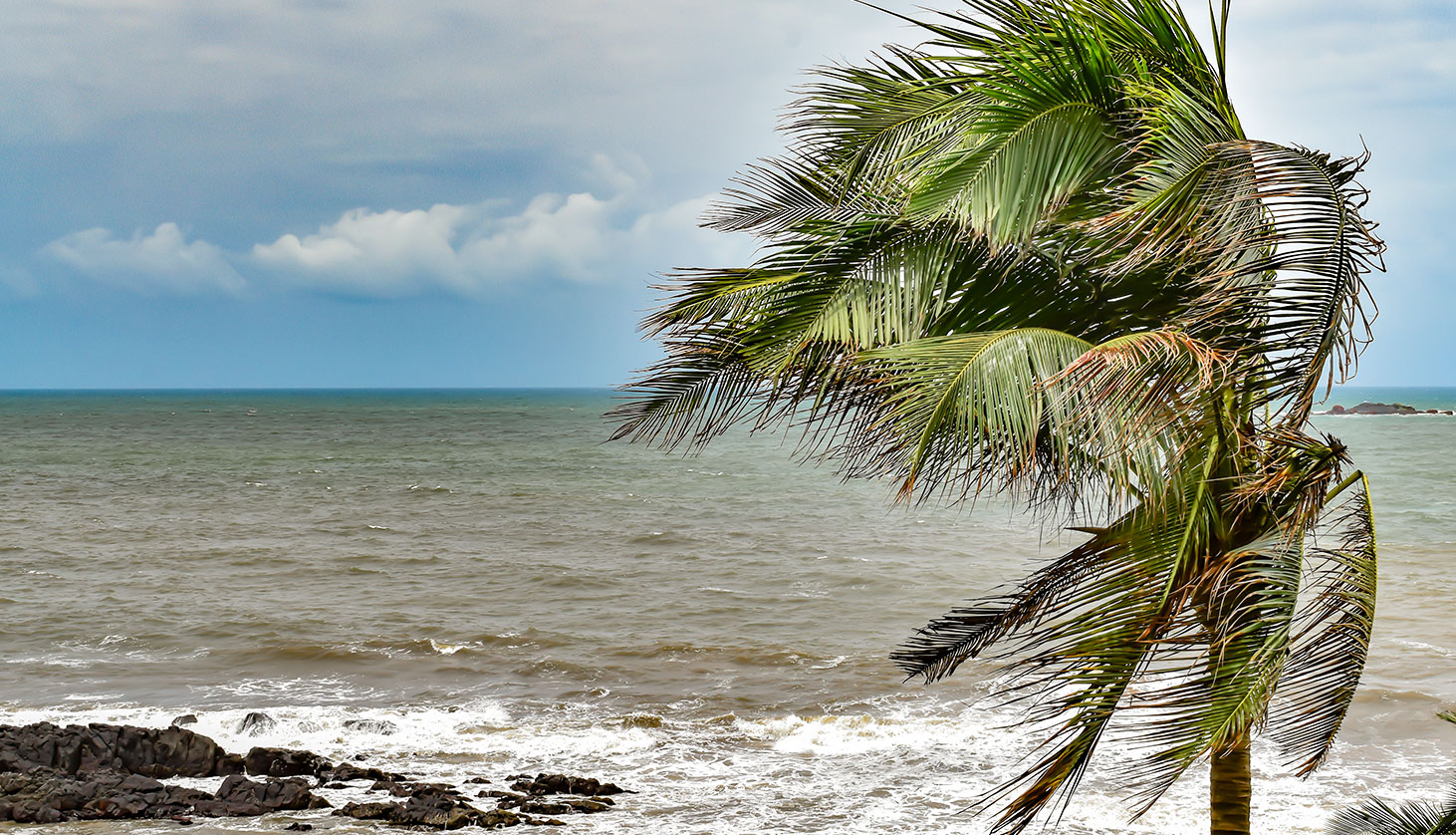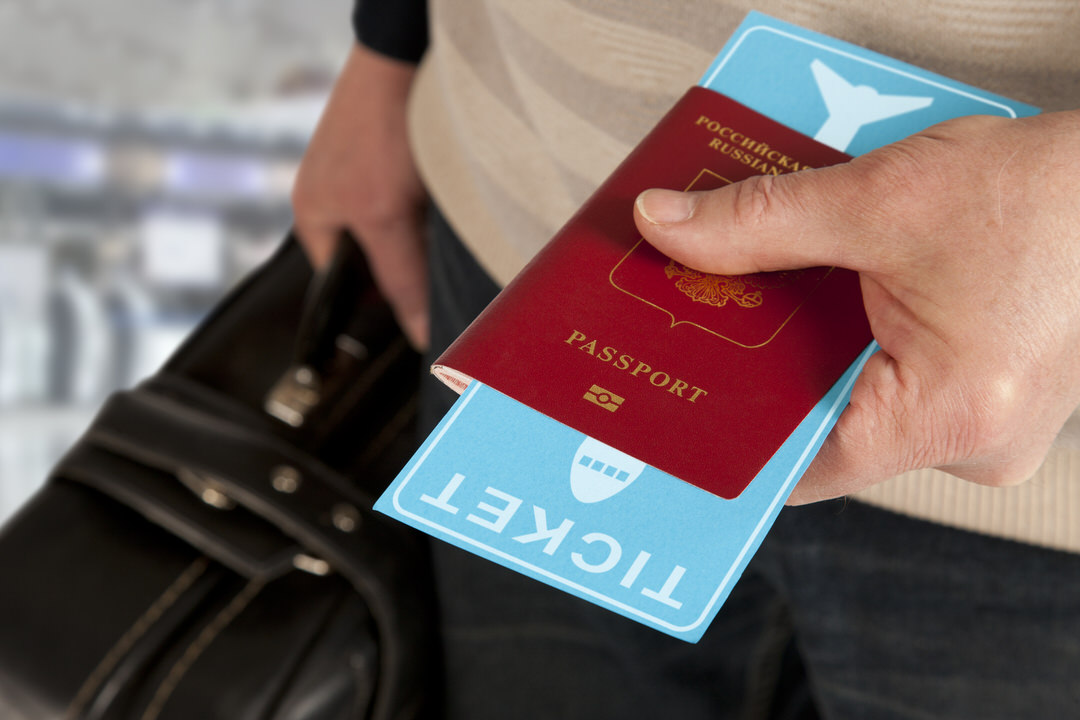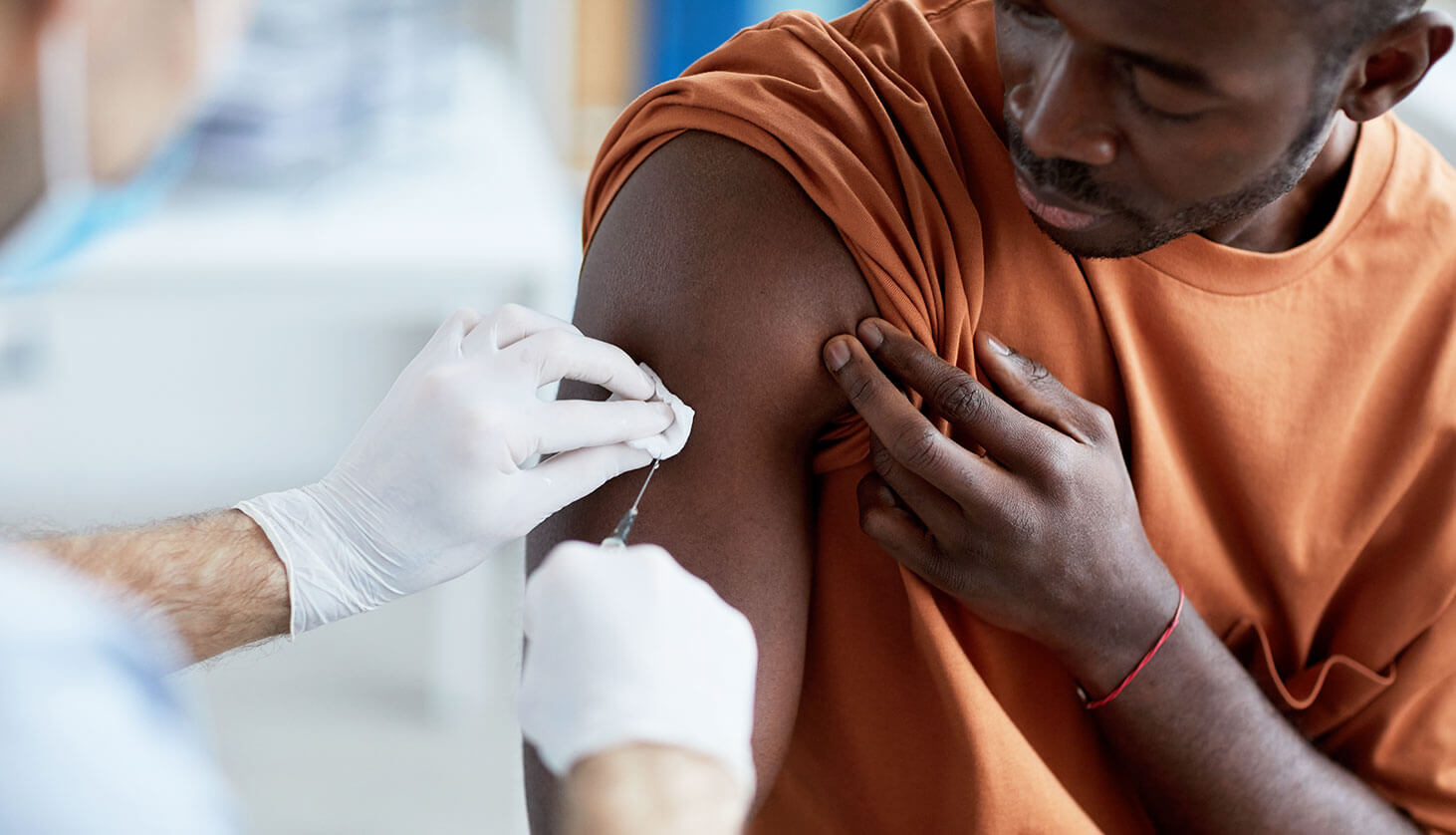Tornadoes are mostly known to touch down in “tornado alley” located in the south-central United States. However, tornadoes can happen anywhere.
For example, America gets an average of more than 1,000 tornadoes a year. Getting caught in a tornado can be scary, especially if you’re away from home on vacation. Thankfully, many experts say that the best way to survive a tornado is to be prepared.
Below, we’ll go over safety precautions for tornado travel including ways to prepare, things to know about tornadoes, what to do when you encounter one, and what you should do after a tornado passes.
Table of Contents
- Traveling During Tornado Season
- How to Prepare for Tornadoes
- What to Do Before a Tornado Touches Down
- What to Do During a Tornado
- What to Do After a Tornado
- Additional Resources for Tornado Safety
Traveling During Tornado Season
Unlike hurricanes, there isn’t a typical “season” for tornadoes. They’ve been recorded all over the world at all times of the year. Different regions are more prone to tornadoes at different times of the year based on when cold, dry air meets with warm, moist air and other factors like wind speed.
Tornadoes more commonly happen in the U.S. from late winter through $mid-summer. They occur mostly between the late afternoon to the evening. Below are times of the year where tornadoes are most common in parts of the United States, but these regions and times can vary.
- Southern plains: May into early June
- Gulf coast: Early spring
- Northern plains and upper midwest: June or July
Travel Insurance Coverage for Tornadoes
Tornadoes can strike without warning and can result in many interruptions for your trip. For example, a tornado may destroy the airport at your destination. Covered scenarios vary between insurance providers and they may classify tornadoes under different categories. Some may exclude specific scenarios that others cover.

Below are a few tornado-related scenarios that your travel insurance may cover.
- Injury or death
- Emergency medical assistance
- Missed flight or connection
- Trip cancellation
- Trip interruption
- Emergency evacuation
Ask your travel insurance providers for details on trip cancellation, trip interruption, and other scenarios that may occur when a tornado strikes.
Fujita Tornado Damage Scale
Dr. T. Theodore Fjuita created the Fujita Tornado Damage scale in 1971. A team of wind engineers and meteorologists implemented the Enhanced Fujita Tornado Damage Scale to update the original F-scale. The scale uses three-second gust speeds to estimate damages. Both scales rate tornado strength based on damages to structures and wind speeds associated with the damage.
| EF Rating | 3 Second Gust (mph) | Damages |
|---|---|---|
| 0 | 65–85 | Gale |
| 1 | 86–110 | Moderate |
| 2 | 111–135 | Considerable |
| 3 | 136–165 | Severe |
| 4 | 166–200 | Devastating |
| 5 | Over 200 | Incredible |
How to Prepare for Tornadoes
Preparation and education before encountering a tornado is your best defense against a tornado. Tornadoes are unpredictable, can form quickly, and last anywhere between a few seconds to more than an hour. Taking time before your trip to educate your group on tornado safety precautions can make a big difference.
Familiarize Yourselves With Tornadoes
Take the time to learn what tornadoes are, understand tornado alerts, what area you’re traveling to, and what a safe shelter looks like. Knowing the basics ahead of time gives you a plan to follow when you’re evacuating to a shelter.
For example, knowing what area you’re in is important since warnings are issued by location. This is especially important if you’re visiting multiple areas during your trip. It’s also important to know the difference between tornado watches and tornado warnings.
- Tornado watches mean tornadoes are possible in your area. You should get your supplies ready, go over your evacuation plans with your group, and prepare to leave. You should also stay tuned to the local news for updates on the tornado.
- Tornado warnings mean a tornado is formed or will form soon. You should shelter immediately at this point.
There are no set criteria for watches since things can greatly change within a few hours.
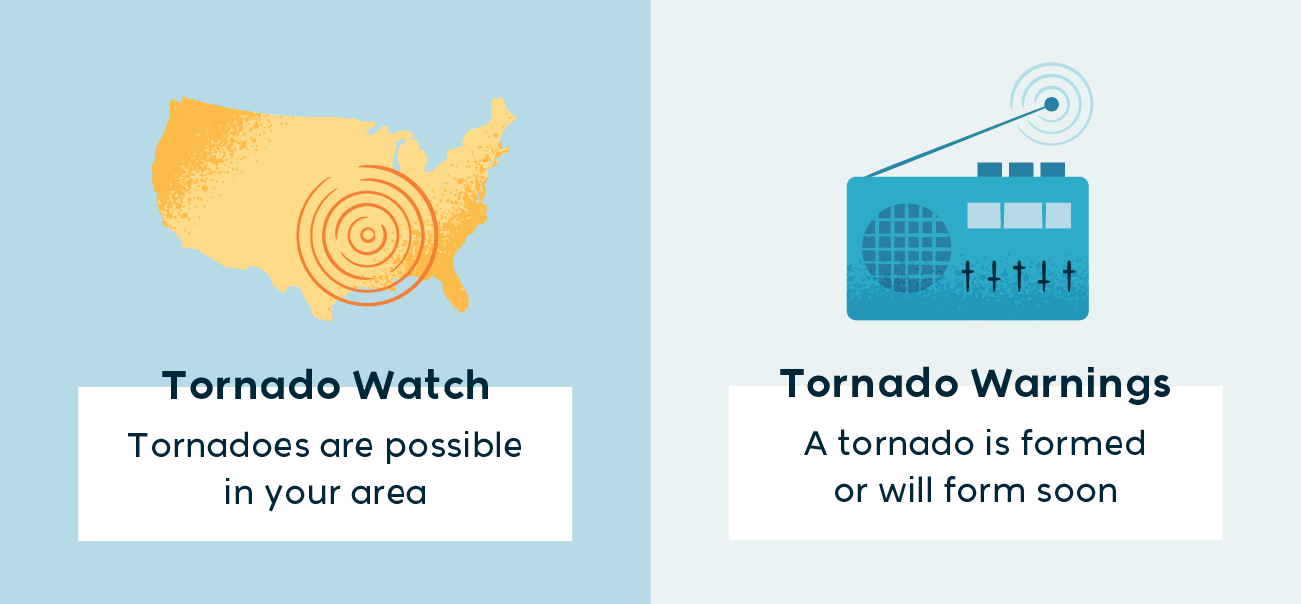
Understand The Qualities of a Good Tornado Shelter
Understanding the general qualities of a good shelter is crucial knowledge when you don’t know where the nearest shelter is located. We’ll go into specific scenarios later in this guide, but these are the things you should know about all tornado shelters.
What to Look For
Aim for rooms close to the ground. Underground rooms like basements or storm cellars are best since it puts you far away from the tornado and flying debris. You should also get to the middle of your shelter room and away from walls to put space between you and the outside. These are ideal qualities you want in a tornado shelter.
- Basements and underground shelters
- Rooms without windows on the lowest floor
- Sturdy furniture to hide under, like heavy tables
- Things to cover yourself with like mattresses and thick blankets
- Interior hallways and stairwells without windows and doors
What to Avoid
Tornado shelters should protect you from debris and put as many walls or barriers between you and the outside as possible. Sheltering in rooms with windows or bridges expose you to flying debris from the tornado. Here are a few places and features to avoid when seeking shelter.
- Rooms with windows
- Elevators
- Mobile homes
- Bridges or underpasses

Know the Signs in the Sky
You can also prepare yourself by knowing what an impending tornado looks and sounds like. You can expect to see and hear the following signs.
- Loud roar like a train
- Big hail
- Dark or green-colored sky
- Big, dark, and low-lying clouds
- Humid, windy and hot weather
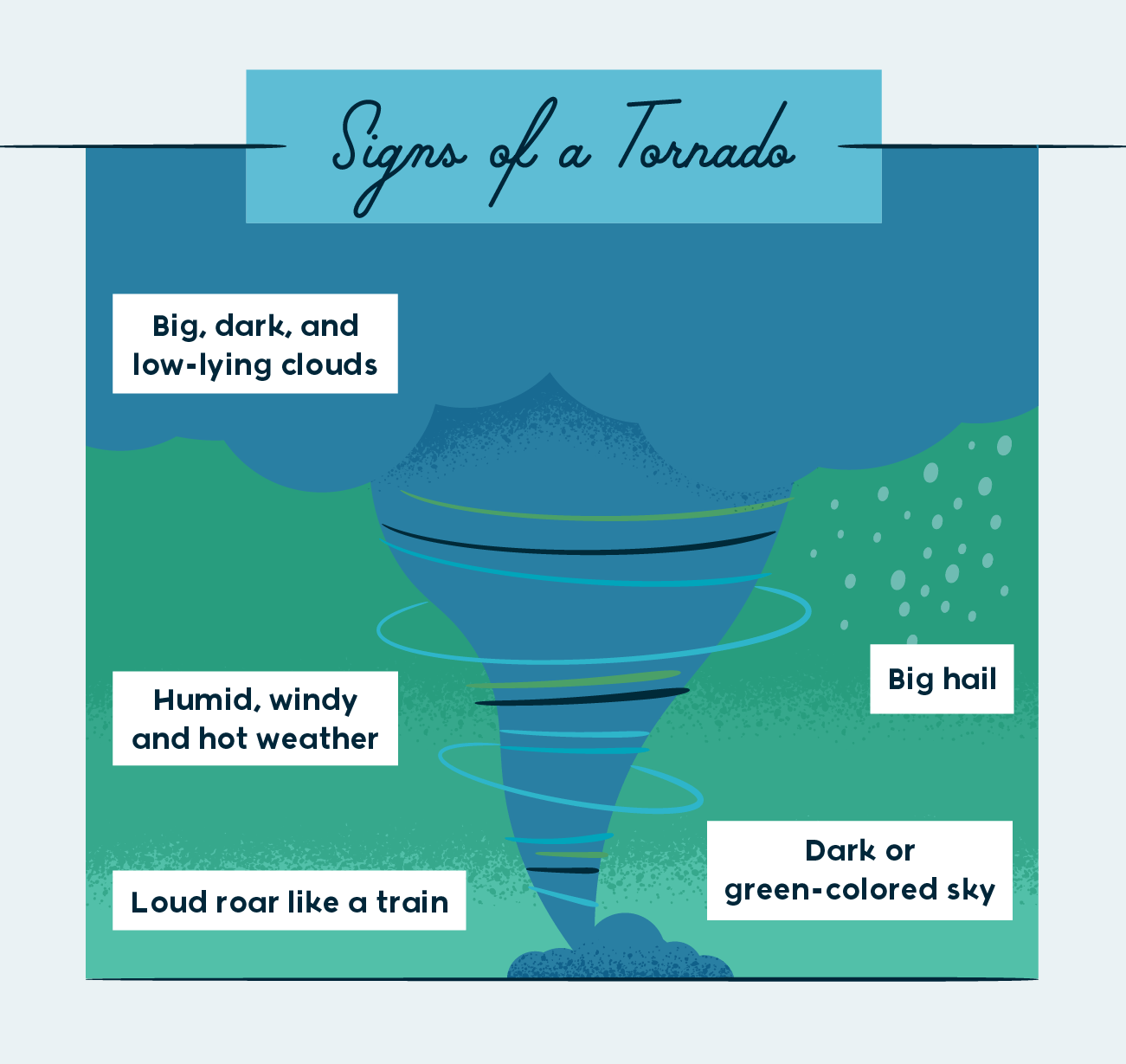
If you notice all of these things, then you should immediately find shelter and tune into local announcements on the radio, TV, or on the internet.
Have Plans in Place
Once you get the basics down, it’s time for your group to get plans in place in case a tornado does form during your trip. These are a few things to consider when planning ahead for a tornado.
- Have a plan for what you’ll do if you’re separated. Phone calls are difficult after a disaster hits, so pick a spot to meet up after it’s safe to leave the shelter.
- Have evacuation plans in place for different locations. Put together a list of places you plan to visit and talk about how you will evacuate and shelter if a tornado arrives. Research online and call each location to get familiar with their individual evacuation and sheltering plans.
- Know your destination’s tornado risk and local response plan. Sign up for your destination’s community warning system and know what a warning siren sounds like if you’re not familiar with it.
- Create a plan for your pets. Prepare a pet emergency kit so your furry friend (or friends) have everything they need.
- Practice your evacuation plan when you arrive at your destination. Although you may not have the chance to practice at every place on your list, you should get familiar with what you’ll do if a tornado forms near your accommodation, while you’re outside, and when you’re on the road.
What to Do Before a Tornado Touches Down
You won’t have much time before a tornado touches down. Knowing your evacuation plan, keeping an eye out for the signs, and staying up-to-date with local authorities can give you a head start on preparations.
You’ll need to move fast once you see the signs of a tornado, especially since some tornadoes form without much warning. You should not drive if a tornado is close since you may get caught in traffic or in the path of the storm. These are the steps you should take before a tornado forms:
- Listen to weather conditions by tuning in to local radio, TV, or NOAA stations. If you see a tornado in the distance and have the time, report it to a local news outlet.
- Quickly go over your evacuation plan with your group and what you’ll do in case you’re separated.
- Bring your safety kit and other necessities, but don’t spend too much time packing. You may not have enough time to secure all of your belongings before the tornado arrives.
- Find shelter and listen to the instructions of the staff and authorities. If you’re unsure of the nearest shelter, find the lowest room in the building, shelter under sturdy furniture, and protect your head and neck. The Center for Disease Control (CDC) has tips for safely staying in a public disaster shelter during the COVID-19 pandemic.
What to Keep in a Safety Kit
A packed safety kit can save you precious time and give you peace of mind when you’re getting your group to safety. The right items can also alleviate strain on healthcare systems and reduce the need to go outside for supplies while sheltering in place. Keep enough stock in your safety kit to sustain your group for at least three days.

Below are a few things to consider keeping in your tornado safety kit.
Medication
- Prescriptions and over-the-counter medicine
- First aid kit
Personal Hygiene
- Cleaning supplies
- Soap
- Hand sanitizer
- Moist towelettes
- Toilet paper
- Paper towels
- Garbage bags and plastic ties
- Face masks
Emergency Supplies
- Emergency plan
- Local maps
- New batteries
- Battery-operated TV or radio (hand crank)
- External charger for your phone
- Important information (phone numbers, social security card)
Food and Beverage
- Water
- Non-perishable food
- Can opener
- Pet food and supplies
Sleeping Supplies
- Blankets
- Sleeping bags
Recreation
- Books
- Puzzles
- Games
What to Do During a Tornado
You’ll need to stay vigilant during a tornado since things can quickly change without warning. When a tornado touches down, move fast to the nearest shelter and stay tuned to the local news. Below are specific steps to take depending on where you find yourself when a tornado forms.
Outside
Look for the nearest shelter if possible. If you’re not near any buildings or shelter, find a place outside to shelter from the tornado.
The best place for an outdoor shelter is low, flat, and far from trees and cars. Once you find your spot, lay flat and face down on the ground while protecting the back of your head and neck with your arms. Be aware of potential flooding in your sheltering spot and watch out for flying debris.
Contrary to popular belief—don’t go to bridges! Although some say this keeps you safe from a tornado, it still exposes you to flying debris.
In a Car
Do not try to out drive a tornado! Tornadoes can quickly change directions and sweep up your vehicle. Don’t ignore the signs of a tornado when you’re on the road either.
If the tornado looks far away, it may be safe to drive to the nearest shelter if it’s a short distance away. If the tornado is close, park your car and find the nearest shelter on foot. Follow the precautions mentioned above for staying safe during a tornado when you’re outside. Use your best judgment on what’s safest for your situation.
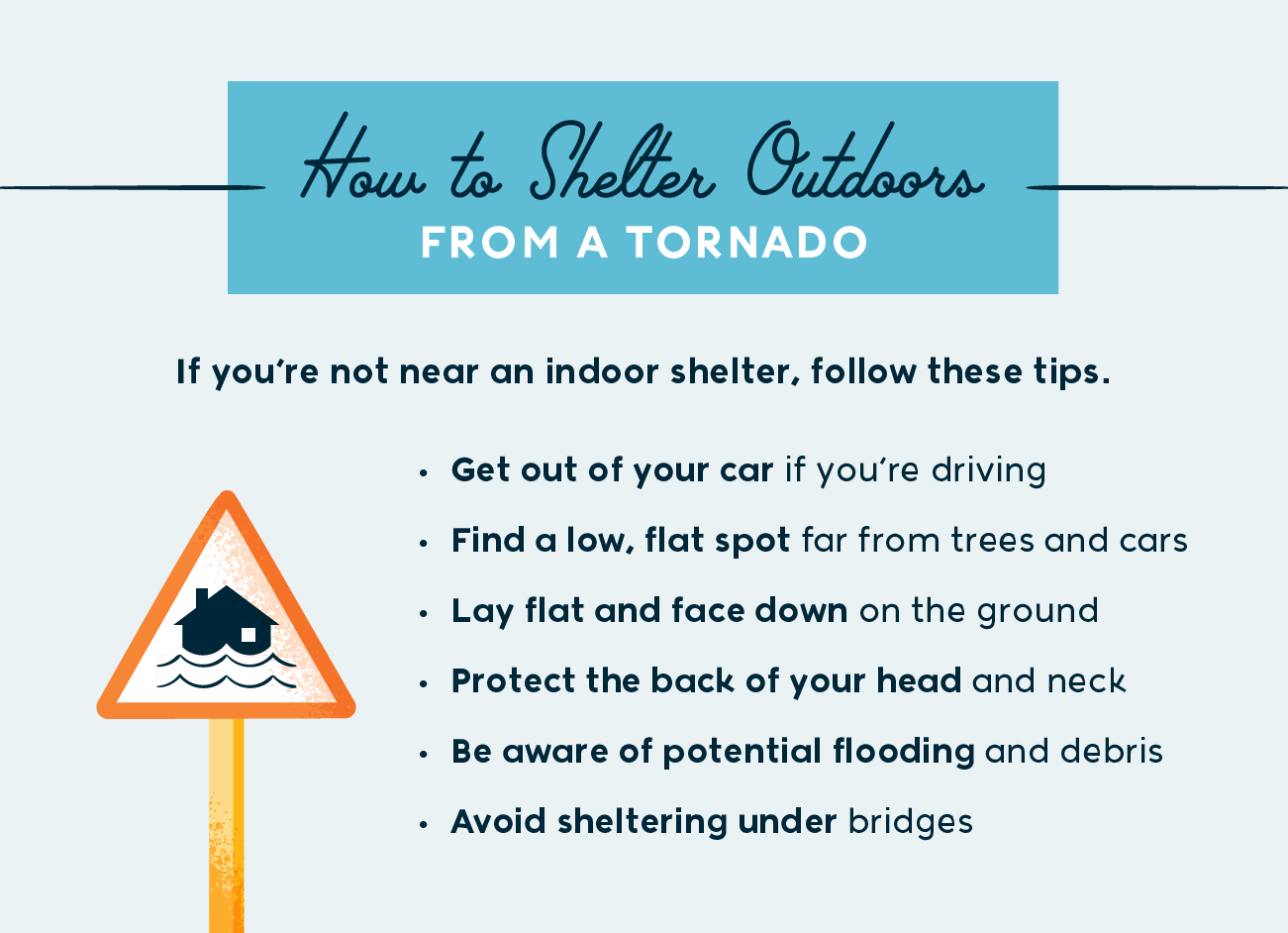
In a Hotel or Rental Accommodation
If you have enough warning, go to your accommodation’s designated sheltering area. If you don’t have enough time, get to the lowest floor. Interior hallways and stairwells with no windows and doors are also good spots if you don’t have time to get to the ground level. Avoid areas with free spanning roofs like auditoriums since those areas are typically supported with outside walls.
Get as low as possible to the floor, get under something sturdy, and protect the back of your head and your neck. Use blankets, mattresses, and other things in your accommodation to protect yourself from debris.
Inside a Building
If you find yourself out and about in a store or other building when a tornado hits, follow the instructions of the staff. They should know where the nearest sheltering area is located in their building. If the staff isn’t sure or you can’t find help, make your way to the lowest level of the building away from outside walls, windows, and doors.
Inside a High-Rise Building
It may not be practical to get to the ground level if you’re in a tall building. Instead, find an interior stairwell or hallway around the middle of the building that you’re more likely to reach before the tornado hits.

What to Do After a Tornado
After a tornado, it’s important to stay informed on the local situation, listen to local authorities, and communicate with loved ones. Follow these steps after the storm passes.
- Stay informed through radio, TV, or the internet. It may not be safe to leave, even if it sounds like the tornado has passed. Take the lead from the authorities for your next steps. Waiting for news is nerve-wracking for some, so you can occupy yourselves with games or other things you brought. The Substance Abuse and Mental Health Services Administration (SAMHSA) has tips for those struggling with sheltering in place.
- Avoid phone calls as much as possible. Voice networks are congested following a disaster. Rely on texts, social media, and other methods to communicate with loved ones. The Federal Communications Commission (FCC) has many tips to communicate during a disaster.
- Check if you or anyone in your group has injuries. Don’t attempt to move anyone unless they’re in a dangerous situation. Call your healthcare provider if you fall ill and call 911 if anyone needs immediate medical attention.
- Help those who might need extra help. Small children, seniors, and people with disabilities are a few groups of people who may need an extra hand.
- Consider volunteering with relief efforts. If you’re willing and able to lend your help, this may be a good time to turn your getaway into a volunteer vacation. Ask local staff and authorities on ways you can help with cleanup and other tasks.
- Avoid post-tornado hazards like damaged buildings and exposed wiring. A study of injuries after a tornado in Marion, Illinois found that half of the injuries happened during cleanups, rescue attempts, and other post-tornado activities.
- Seek help for stress and anxiety. It’s normal to feel many emotions after an event like this. Whether it’s you or a loved one, don’t be afraid to seek help and encourage others to seek help. The American Psychological Association (APA) has tips for managing stress after a tornado.
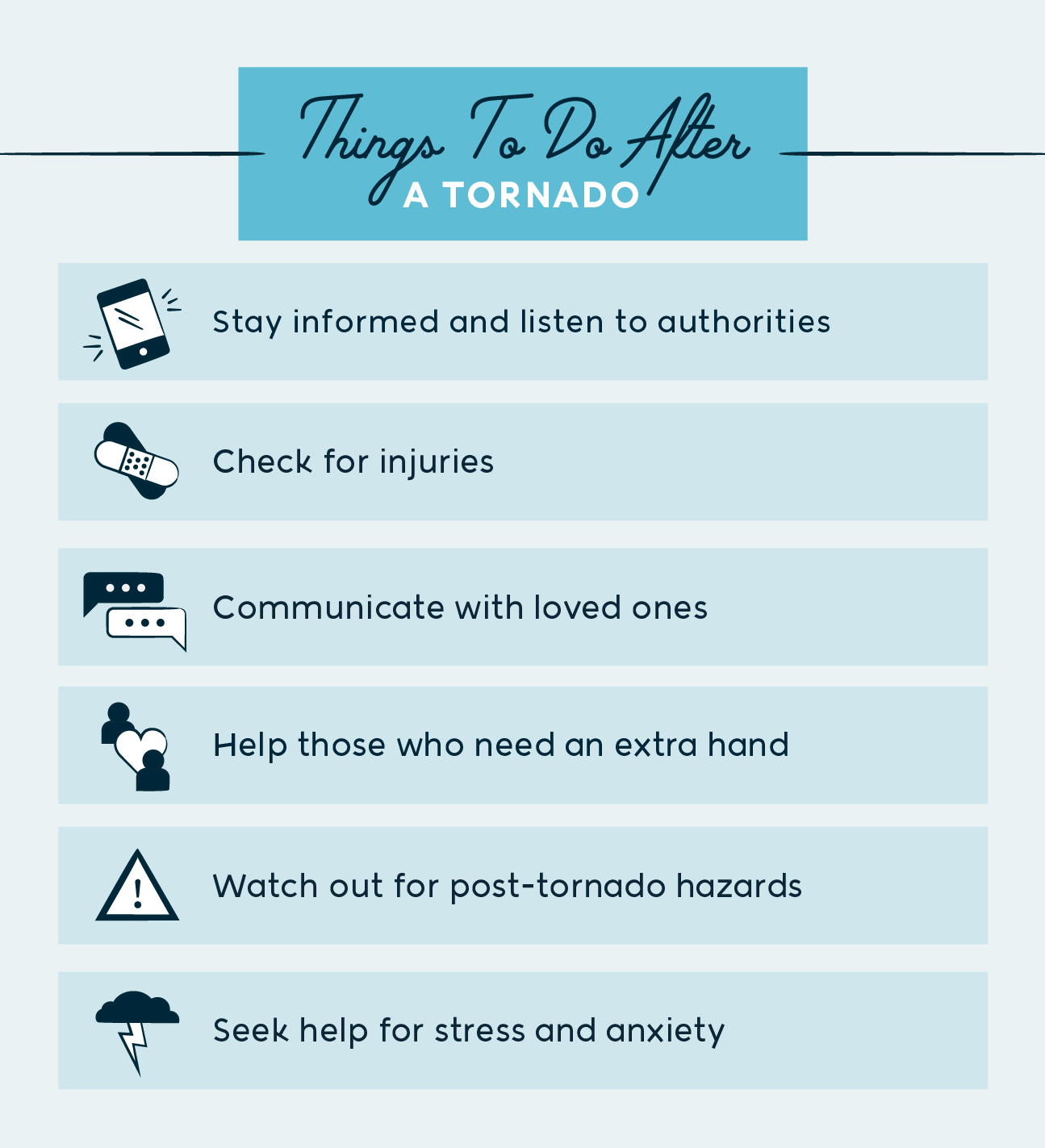
Additional Resources for Tornado Safety
You can take a look at the below resources to learn more about the science of tornadoes and how you can prepare yourself and your loved ones. You should also look into local safety resources for your destination and accommodations to get familiar with their procedures.
- Federal Emergency Management Agency (FEMA)
- National Weather Service
- The National Child Traumatic Stress Network
- Environmental Protection Agency
- Weather Underground
- Occupational Safety and Health Administration
- Substance Abuse and Mental Health Services Administration
- American Society for the Prevention of Cruelty to Animals (ASPCA)
Keep calm and stick to your plan if you get a tornado warning while you’re out on vacation. Preparation is key to ensuring you and your loved ones will be as safe as possible if a tornado touches down during your trip. Safe travel to the Florida Panhandle and any other destination is possible as long as you keep up with the local news and have a plan in place in case a storm touches down.
Sources
National Severe Storms Laboratory | National Centers for Environmental Information 1, 2 | National Oceanic and Atmospheric Administration | National Geographic | Storm Prediction Center 1, 2 | National Weather Service 1, 2, 3 | Accuweather | Travel Insurance Review 1, 2
Disclaimer: FloridaPanhandle.com does not provide legal or medical advice. This post has been prepared for informational purposes only. All users are advised to check all applicable local, state, and federal laws and safety procedures and consult legal and medical counsel should questions arise.

